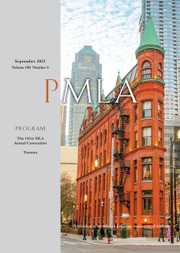Article contents
The Coward Knight and the Damsel of the Car
Published online by Cambridge University Press: 23 February 2021
Extract
Among the many curious episodes in the Grail Romance, Perlesvaus, that of the Coward Knight has received comparatively little attention. It is mentioned by Birch-Hirschfeld and by Brugger and a few pages are devoted to it by Professor Nitze in his dissertation. The most recent, as well as the fullest, treatment which it has received thus far is that given to it by Miss Jessie Weston. Professor Nitze and Miss Weston make the story of the Coward Knight the basis of their argument as to the relative date of Perlesvaus and Manessier's continuation of Chrétien, since this happens to be the only episode common to these two texts. But though they deal with precisely the same evidence they arrive at opposite conclusions. The question, therefore, appears to be one which invites further discussion. Before considering their arguments, however, it will be convenient to have before us an outline of those portions of the romance which deal with the Coward Knight and his lady, the Damsel of the Car.
- Type
- Research Article
- Information
- Copyright
- Copyright © Modern Language Association of America, 1928
References
1 Tr. by Sebastian Evans with the title. The High History of the Holy Grail, London 1910.
2 Die Sage vom Gral, Leipzig, 1877.
3 “Enterrement Merlin,” Zfl. für fratuös. Spracha, XXIX.
4 W. A. Nitze, The Old French Grail Ramance, Perlesvaus, Baltimore 1902 (Johns Hopkins Univ. Diss.).
5 “The Perlesvaus and the Story of the Coward Knight,” Mod. Phil., XX (1922), 379-397.
6 Branch II-Title 4, p. 32.
7 Branch IV, Title 5 and 6, pp. 51-2.
8 Branch XII, 1, p. 154.
9 Branch XVII, 4-7, pp. 200 ff.
10 Branch XXXII, 1-3, pp. 327 ff.
11 Branch XXXV, 25, p. 376.
12 Ibid., II, 1-2, pp. 23 ff; 2-4, pp. 26 ff; II™, pp. 33-4; VI, 11, pp. 80-1; IX, 2-7, pp. 112 ff; 11-18, pp. 118 ff; XI, 1, p. 141; XV, 32, p. 194; XXII, 4, p. 269; XXXII, 11, p. 334; XXXII, 13, p. 336; XXXV, 22, p. 372; XXV, 26, p. 376.
13 Nitze, op. cit., p. 84.
14 C. H. Carter, Ipomedon (Haverford Essays), Haverford, 1909, p. 237. The reference to the Coward Knight story in this romance I owe to Professor Carleton Brown.
15 Ipomedon, ed. E. Kölbing, Breslau 1889, stanza 44.
16 Nitze, op. cit., p. 86 and note p. 87.
17 Weston, The Legend of Sir Perceval; London 1909, II, 202.
18 Elton, Folk-lore Sec. Publ., II™, 108.
19 Med. Phil., XVII (1919), 161 n.
20 J. D. Bruce, The Evolution of the Arthurian Romance, from the Beginning, to the Year-1300, 1923, II, 18.
21 Ibid., II, 19.
22 Evans, VI, 12, p. 81.
23 Reproduced by Emil Mâle, L'Art religieux du 13e siècle en France. Paris, 1923, p. 195, and n. 3.
24 Mile, L'Art religieux du 12 siède m France, Paris, 1922, p. 159.
25 Cf. Longinus who symbolically recovers hit sight by the blood of Christ. It is this same idea of spiritual blindness which led to the representation of the Jewish people by an owl, in the cathedrals of Main, of Poitiers, in a church of Avesnières; on misericords at Ely and Gloucester. (See Mile, 12e siècle, p. 333, and Francis Bond, Wood Carving in English Churches, v. I, “Misericords,” London, 1910, p. 47.)
26 Lewis Spence, The Gods of Mexico, London, 1923, p. 338.
27 Such are: Deuteronomy 28: 18; I Samuel 15: 10, 11; II Chronicles 29: 6; Job 34: 26, 27; Jeremiah 32: 33; Zephaniah 1:6; perhaps also Psalms 78: 41, and Lamentations 1: 13.
28 Or, as the phrase is translated in the American revised version, Turned their back, and not their face“ (American Standard ed. of the Bible, 1901).
29 See the reproduction by Mâle, Art religieux du XIIIe siècle, p. 229, fig. 101.
30 The Southern Passion, ed. Mrs. Carleton Brown, EETS, Or. Ser. 169, vv. 1809 10.
31 Reproduced in Dr. I. N. MacCracken's edition of Lydgate't Serpent of Division, London, 1911, p. 56.
32 Chambers, The Mediaeval Stage, Oxford 1913, I, pp. 320-21.
33 Ib., p. 261, n. 3.
34 EETS, or. ser. 35, 37, pp. 463 ff.
35 F. E. Hulme, History, Principles and Practice of Symbolism in Christian Art London 1899, p. 211.
36 Jeremias, The Old Testament in the light of the Ancient East, v. II, p. 126.
37 Ib., pp. 130-31.
38 M. Didron, Christian Iconography, v. I, tr. E. J. Millington, London 1851, p. 417.
39 J. B. Fletcher, Symtolism of the Divine Comedy, New York 1921, p. 86.
40 Ibid., pp. 82 and 85.
41 Hulme, op. cit., pp. 176-77.
42 Nitze cites as “an excellent example of the Christianizing spirit, the sealed heads which the Damsel of the Car carries about.” He considers it an elaboration of Revelations 7: 3 (M. Ph., 17, 161 n.) and although this in no way furthers our thesis, it is an interesting'point to note.
43 Brace, op. cit., II, 157-59. The italics are mine.
44 Hengwrt MS, I, 592.
45 G. Baist, Cresiens von Troyes conte del Graal, Freiburg 1909, 1. 4609.
46 “The Sitter's Son and the Conte del Graal,” Mod. Phil., IX, 296.
47 Kittredge, M.L.N., VIII (1893), 231.
48 Nitze, Old Fr. Grail Romance Perlesvaus, p. 63.
- 1
- Cited by




